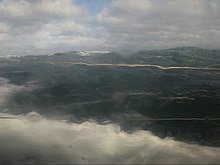White squall

A white squall ( English white squall ) is an extremely strong, emerging without warning Fallbö , which is partially accompanied by fog, rain or snow fall.
White gusts are a rare and feared weather phenomenon on the high seas in maritime shipping. Without the usual signs of certain storm clouds, the sea turns white as a result of the sudden gusts of wind (whitecaps on the waves); sometimes a rising white cloud builds up extremely quickly when the sky is otherwise clear. These accompanying phenomena - white foam crowns, fog, the cloud and, in certain latitudes, also snow - gave the phenomenon its name.
The cause of this phenomenon is likely to be strong changes such as air pressure drops in cloud layers in the upper atmosphere, which virtually trigger a jerky air avalanche of hurricane strength and lead to extreme turbulence like in hurricanes down to sea level. The event usually lasts only a few seconds to a few tens of minutes. This phenomenon is particularly dangerous for sailing ships, as it is very difficult to detect it early enough and therefore leaves no possibility of countermeasures such as reducing the sail area and course correction.
This weather phenomenon, often described in literature from the 19th century, was often dismissed as a sailor's thread because of its rarity and underestimated by many sailors. The sailing training ship Niobe sank in 1932 in the Baltic Sea off the island of Fehmarn in such a gust.
Only recently have white gusts been recognized more frequently as a cause of disaster. On May 2, 1961, the sailing training ship Albatross sank on the voyage from Mexico to Nassau in the Bahamas (filmed as White Squall ), which is partly attributed to a white gust . The event triggered a review by the US Coast Guard of the regulations governing the construction of sailing school ships, which resulted in a legislative resolution in 1982 (Sailing School Vessels Act of 1982). A similar misfortune befell the Rahschoner Pride of Baltimore , a replica of a historic Baltimore clipper , on May 14, 1986: The ship was probably hit 250 nautical miles north of Puerto Rico by a white squall and sank. The captain and three crew members died; the eight survivors were rescued from a life raft four days and seven hours later by the Norwegian tanker Toro . For both sinkings, however, the windjammer sailor Daniel Parrott was able to collect information that made a white gust unlikely as the sole cause of the accident and called into question the sufficient stability of the ships, which was primarily impaired by large sail areas. Parrott does not rule out the occurrence of white gusts in general, but argues against the irresistible strength of the gusts in the two specific cases, since they could probably have been weathered with sufficient stability .
Some sailors also suspected a white gust as the cause of the sudden disappearance of the German five-masted barque Maria Rickmers after leaving the Sunda Strait on July 24, 1892 in the Indian Ocean.
See also
Individual evidence
- ^ Daniel S. Parrott: Tall Ships Down - The Last Voyages of the Pamir , Albatross, Marques, Pride of Baltimore, and Maria Asumpta . McGraw Hill, 2003, ISBN 0-07-139092-8 .
literature
- Charles "Chuck" Gieg, Felix Sutton: The Last Voyage of the Albatross. Duel, Sloan and Pearce, New York 1962. (Report from the last voyage of the Albatross)
- John Conroy Hutcheson: The White Squall: a Story of the Sargasso Sea. Blackie & Son, London 1887 and 1893.
- Richard E. Langford: White Squall: The Last Voyage of Albatross. Bristol Fashion, 2000, ISBN 1-892-216361 . (Report from the last voyage of the Albatross)